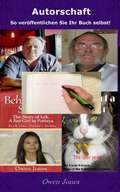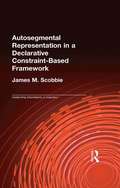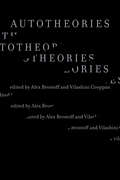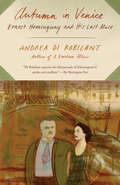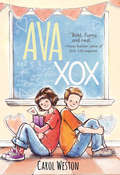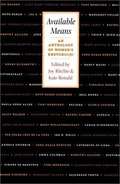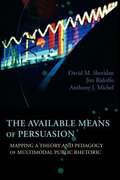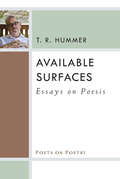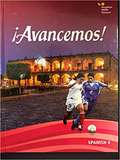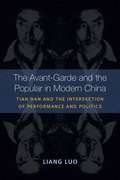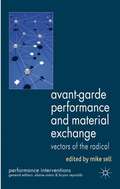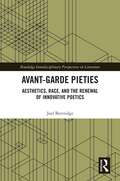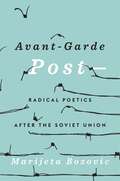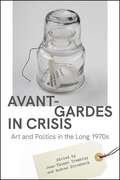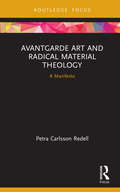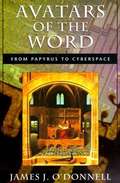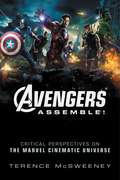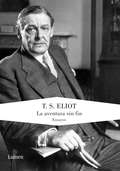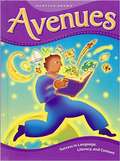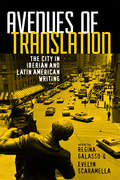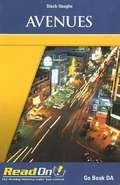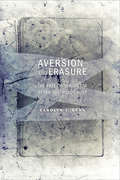- Table View
- List View
Autorschaft: So veröffentlichen Sie Ihr Buch selbst!
by Owen JonesAutorschaft So veröffentlichen Sie Ihr Buch selbst! Dieses Buch richtet sich an alle Autoren, die ihre Bücher in gedruckter oder elektronischer Form oder in beiden Formaten selbst veröffentlichen möchten, aber sich nicht trauen. Ich selbst habe über hundert Bücher bei allen großen Druckereien und Vertreibern veröffentlicht, daher war ich überrascht, vor Kurzem zu erfahren, dass einige exzellente Schriftsteller die Selbstveröffentlichung ablehnen, weil sie die Aufgabe als zu verwirrend und schwierig empfinden und sie lieber andere bezahlen um dies für sie zu erledigen. Ich kann es verstehen, wenn ein Autor Zeit sparen möchte, daher ist der Zweck dieses Buches, denen zu helfen, die den Job selbst erledigen möchten, aber nicht wissen, wie. Es ist tatsächlich sehr befriedigend, die Idee für ein Buch zu empfangen, es zu schreiben und dann selbst zu veröffentlichen und mit Hilfe dieses Buches können Sie genau das tun. Hier erfahren Sie, wie Sie Veröffentlichungen auf allen wichtigen Verteilern wie Amazon, iBookstore, Barnes und Noble, Lulu, Nook, Kindle, Smashwords und XinXii vornehmen können.
Autosegmental Representation in a Declarative Constraint-Based Framework (Outstanding Dissertations in Linguistics)
by James M. ScobbieFirst Published in 1998. Routledge is an imprint of Taylor & Francis, an informa company.
Autotheories
by Alex Brostoff and Vilashini CooppanA transdisciplinary array of authors offering a new frame of reference for autotheory and its genre-bending synthesis of autobiography and critical theory.Autotheories tells the story of a field in formation. Building on traditions that have long fused life writing, philosophical encounter, embodied theorizing, and cultural critique, autotheory constructs new practices of critical theory. Transgressing generic boundaries and bridging stylistic registers, it crafts language that is intimate, analytic, playful, and insurgent. Editors Alex Brostoff and Vilashini Cooppan underscore autotheory&’s multiple genealogies and genre-bending forms while situating it within the contemporary political field. In this collection, autotheory emerges as a strut (of style), a straddle (of disciplines), a proliferation (of selves), an axis (of identifications), an index (of attachments), and an archive (of loves). An assemblage and an experience, Autotheories surveys the field&’s iterations and permutations. Without settling for classification or bowing to ossification, Autotheories invites you to its discursive play.Contributors include:Alex Brostoff, Jessica Bush, Judith Butler, Vilashini Cooppan, Carla Freccero, rl Goldberg, Jan Grue, Emma Lieber, Megan Moodie, Lili Owen Rowlands, John Patterson, Paul B. Preciado, Erica Richardson, Migueltzinta C. Solís, Jamieson Webster, Damon Ross Young, Stacey Young, Arianne Zwartjes
Autumn in Venice: Ernest Hemingway and His Last Muse
by Andrea Di RobilantThe acclaimed author of A Venetian Affair now gives us the remarkable story of Hemingway's love affair with both the city of Venice and the muse he found there--a vivacious eighteen-year-old who inspired the man thirty years her senior to complete his great final work.In the fall of 1948 Hemingway and his fourth wife traveled for the first time to Venice, which Hemingway called "a goddam wonderful city." He was a year shy of his fiftieth birthday and hadn't published a novel in nearly a decade. At a duck shoot in the lagoon he met and fell in love with Adriana Ivancich, a striking Venetian girl just out of finishing school. Di Robilant--whose great-uncle moved in Hemingway's revolving circle of bon vivants, aristocrats, and artists--re-creates with sparkling clarity this surprising, years-long relationship. Hemingway used Adriana as the model for Renata in Across the River and into the Trees, and continued to visit Venice to see her; when the Ivanciches traveled to Cuba, Adriana was there as he wrote The Old Man and the Sea. This illuminating story of writer and muse--which also examines the cost to a young woman of her association with a larger-than-life literary celebrity--is an intimate look at the fractured heart and changing art of Hemingway in his fifties.
Ava XOX
by Carol WestonLove is in the air-and Ava thinks she's allergicValentine's Day is just around the corner, and Ava couldn't care less. That is, until a new girl, Kelli, asks out Ava's friend Chuck...and he says yes! What?!? Ava is NOT okay with this. But since when does she think about boys? For the first time ever, words fail Ava. She isn't sure what she's feeling (Like? Love? Friendship? Frustration?), or what "going out" even means. After all, fifth graders aren't allowed to go anywhere by themselves, are they?To top it off, Pip's friend Tanya is being bullied for her size. Ava wants to help-but, uh oh, it's not as easy as she imagines.The New York Times called AVA AND PIP "a love letter to language. " With this third diary format, Girls' Life advice columnist Carol Weston hits another home run.Don't miss how it all began in:Ava and PipAva and Taco Cat
Available Means: An Anthology Of Women's Rhetoric
by Joy Ritchie Kate RonaldAvailable Means offers seventy women rhetoricians—from ancient Greece to the twenty-first century—a room of their own for the first time. Editors Joy Ritchie and Kate Ronald do so in the feminist tradition of recovering a previously unarticulated canon of women’s rhetoric. Women whose voices are central to such scholarship are included here, such as Aspasia (a contemporary of Plato’s), Margery Kempe, Margaret Fuller, and Ida B. Wells. Added are influential works on what it means to write as a woman—by Virginia Woolf, Adrienne Rich, Nancy Mairs, Alice Walker, and Hélène Cixous. Public “manifestos” on the rights of women by Hortensia, Mary Astell, Maria Stewart, Sarah and Angelina Grimké, Anna Julia Cooper, Margaret Sanger, and Audre Lorde also join the discourse. <p><p> But Available Means searches for rhetorical tradition in less obvious places, too. Letters, journals, speeches, newspaper columns, diaries, meditations, and a fable (Rachel Carson’s introduction to Silent Spring) also find places in this room. Such unconventional documents challenge traditional notions of invention, arrangement, style, and delivery, and blur the boundaries between public and private discourse. Included, too, are writers whose voices have not been heard in any tradition. Ritchie and Ronald seek to “unsettle” as they expand the women’s rhetorical canon. <p> Arranged chronologically, Available Means is designed as a classroom text that will allow students to hear women speaking to each other across centuries, and to see how women have added new places from which arguments can be made. Each selection is accompanied by an extensive headnote, which sets the reading in context. The breadth of material will allow students to ask such questions as “How might we define women’s rhetoric? How have women used and subverted traditional rhetoric?” <p> A topical index at the end of the book provides teachers a guide through the rhetorical riches. Available Means will be an invaluable text for rhetoric courses of all levels, as well as for women’s studies courses.
The Available Means of Persuasion: Mapping a Theory and Pedagogy of Multimodal Public Rhetoric
by David M. Sheridan Jim Ridolfo Anthony J. MichelExploring the ways that public rhetoric has changed due to emerging technologies that enable people to produce, reproduce, and distribute compositions that integrate visual, aural, and alphabetic elements, the authors argue that to exploit such options fully, rhetorical theory and pedagogy need to be reconfigured.
Available Surfaces: Essays on Poesis
by Hummer T. R."T. R. Hummer grew up in the Deep South and planned to become a musician before he met poetry. This musical influence is visible in his work: he often discusses poetry together with music (and sometimes the other way around), and his career has included both writing and performance. The present volume, Available Surfaces, focuses on the art of making both poetry and music and on the concept of "making" as well. Hummer draws on childhood experiences ("A Length of Hemp Rope"), adult experiences ("Hotel California"), experiences as a poet ("Available Surfaces"), and experiences as an explorer of unworldly spaces ("The Hive," "Brain Wave and the End of Science Fiction"). Hummer has published ten volumes of poetry with presses including Louisiana State University Press and the University of Illinois Press. His work has appeared in two anthology volumes published by Simon & Schuster and Cengage and in two Pushcart Prize anthologies. He has edited the Kenyon Review, the Georgia Review, and the Cimarron Review, among other journals. "--
The Avant-garde And The Popular In Modern China: Tian Han And The Intersection Of Performance And Politics
by Liang LuoThe Avant-Garde and the Popular in Modern China explores how an important group of Chinese performing artists invested in politics and the pursuit of the avant-garde came to terms with different ways of being "popular" in modern times. In particular, playwright and activist Tian Han (1898-1968) exemplified the instability of conventional delineations between the avant-garde, popular culture, and political propaganda. Liang Luo traces Tian's trajectory through key moments in the evolution of twentieth-century Chinese national culture, from the Christian socialist cosmopolitanism of post-WWI Tokyo to the urban modernism of Shanghai in 1920s and 30s, then into the Chinese hinterland during the late 1930s and 40s, and finally to the Communist Beijing of the 1950s, revealing the dynamic interplay of art and politics throughout this period. Understanding Tian in his time sheds light upon a new generation of contemporary Chinese avant-gardists (Ai Wei Wei being the best known), who, half a century later, are similarly engaging national politics and popular culture.
Avant-Garde Canadian Literature
by Gregory BettsIn Avant-Garde Canadian Literature, Gregory Betts draws attention to the fact that the avant-garde has had a presence in Canada long before the country's literary histories have recognized, and that the radicalism of avant-garde art has been sabotaged by pedestrian terms of engagement by the Canadian media, the public, and the literary critics. This book presents a rich body of evidence to illustrate the extent to which Canadians have been producing avant-garde art since the start of the twentieth century.Betts explores the radical literary ambitions and achievements of three different nodes of avant-garde literary activity: mystical revolutionaries from the 1910s to the 1930s; Surrealists/Automatists from the 1920s to the 1960s; and Canadian Vorticists from the 1920s to the 1970s. Avant-Garde Canadian Literature offers an entrance into the vocabulary of the ongoing and primarily international debate surrounding the idea of avant-gardism, providing readers with a functional vocabulary for discussing some of the most hermetic and yet energetic literature ever produced in this country.
Avant-Garde Performance and Material Exchange
by Mike SellAssembling a remarkable group of scholars, these essays explore how the circulation and exchange of 'vectors of the radical' shape the avant-garde. Mapping the movement of scripts, theatre activists, performances, and other material entities, they provide unprecedented perspectives on the transnational performance culture of the avant-garde.
Avant-Garde Pieties: Aesthetics, Race, and the Renewal of Innovative Poetics (Routledge Interdisciplinary Perspectives on Literature)
by Joel BettridgeAvant-Garde Pieties tells a new story about innovative poetry; it argues that the avant-garde-now more than a century old-persists in its ability to nurture interesting, provocative, meaningful, and moving poems, despite its profound cultural failings and its self-devouring theoretical compulsions. It can do so because a humanistic strain of its radical poetics compels adherents to argue over the meaning of their shared political and aesthetic beliefs. In ways that can be productively thought of as religious in structure, this process fosters a perpetual state of crisis and renewal, always returning innovative poetry to its founding modernist commitments as a way to debate what the avant-garde is-what it should and does look like, and what it should and does value. Consequently, Avant-Garde Pieties makes way for a radical poetics defined not by formal gestures, but by its debate with itself about itself. It is a debate that honors the tradition's intellectual founding as well as its cultural present, which includes aesthetic multiformity, racialized and gendered modes of authorship, experiences of the sacred, political activism, and generosity in critical disagreement.
Avant-Garde Post–: Radical Poetics after the Soviet Union
by Marijeta BozovicThe remarkable story of seven contemporary Russian-language poets whose experimental work anchors a thriving dissident artistic movement opposed to both Putin’s regime and Western liberalism.What does leftist art look like in the wake of state socialism? In recent years, Russian-language avant-garde poetry has been seeking the answers to this question. Marijeta Bozovic follows a constellation of poets at the center of a contemporary literary movement that is bringing radical art out of the Soviet shadow: Kirill Medvedev, Pavel Arseniev, Aleksandr Skidan, Dmitry Golynko, Roman Osminkin, Keti Chukhrov, and Galina Rymbu. While their formal experiments range widely, all share a commitment to explicitly political poetry. Each one, in turn, has become a hub in a growing new-left network across the former Second World.Joined together by their work with the Saint Petersburg–based journal [Translit], this circle has staunchly resisted the Putin regime and its mobilization of Soviet nostalgia. At the same time, the poets of Avant-Garde Post– reject Western discourse about the false promises of leftist utopianism and the superiority of the liberal world. In opposing both narratives, they draw on the legacies of historical Russian and Soviet avant-gardes as well as on an international canon of Marxist art and theory. They are also intimately connected with other artists, intellectuals, and activists around the world, collectively restoring leftist political poetry to global prominence.The avant-garde, Bozovic shows, is not a relic of the Soviet past. It is a recurrent pulse in Russophone—as well as global—literature and art. Charged by that pulse, today’s new left is reimagining class-based critique. Theirs is an ongoing, defiant effort to imagine a socialist future that is at once global and egalitarian.
Avant-Gardes in Crisis: Art and Politics in the Long 1970s
by Jean-Thomas Tremblay; Andrew StrombeckAvant-Gardes in Crisis claims that the avant-gardes of the late twentieth and early twenty-first centuries are in crisis, in that artmaking both responds to political, economic, and social crises and reveals a crisis of confidence regarding resistance's very possibility. Specifically, this collection casts contemporary avant-gardes as a reaction to a crisis in the reproduction of life that accelerated in the 1970s—a crisis that encompasses living-wage rarity, deadly epidemics, and other aspects of an uneven management of vitality indexed by race, citizenship, gender, sexual orientation, class, and disability. The contributors collectively argue that a minoritarian concept of the avant-garde, one attuned to uneven patterns of resource depletion and infrastructural failure (broadly conceived), clarifies the interplay between art and politics as it has played out, for instance, in discussions of art's autonomy or institutionality. Writ large, this book seeks to restore the historical and political context for the debates on the avant-garde that have raged since the 1970s.
Avantgarde Art and Radical Material Theology: A Manifesto (Routledge Focus on Religion)
by Petra Carlsson RedellTheological thought has long been focused on the meaning to be found in our existence, but it has tended to neglect what it might offer to those seeking how to prolong and improve our physical existence in this world. In conversation with twentieth-century materialist art and thought, this book presents a radical theology that engages directly with the political and ecological issues of our time. The book introduces a new thinker to the theological sphere, Russian avantgarde artist Liubov Popova (1889–1924). She was a woman acknowledged for her artistic and intellectual talent and yet is never discussed in relation to the twentieth-century thinkers with whom her ideas have obvious connections. Popova’s art and thought are discussed together with thinkers like Walter Benjamin, Donna Haraway, Gilles Deleuze and Paul Tillich, along with ecotheological and theopolitical perspectives. Inspired by the activist creativity of avantgarde art, the book’s final chapter, playfully yet with deadly seriousness, presents a manifesto for radical theology today. This is a work of theological activism that demonstrates the benefit of allowing new voices into the conversations around art, spirituality and our planet. As such, it will be of keen interest to academics in Theology, Religion and the Arts and the Philosophy of Religion.
Avatars of the Word: From Papyrus to Cyberspace
by James J. O'DonnellConsiders the future of the printed word given the growth of electronic communication as a modern medium for information and culture. In investigating past cultural transitions, such as from the spoken to the written word, or from manuscript to the printing press, O'Donnell (classical studies, U. of Pennsylvania) reveals the contemporary crossroads between media as contiguous with the history of communication. Annotation c. by Book News, Inc. , Portland, Or.
Avengers Assemble!: Critical Perspectives on the Marvel Cinematic Universe
by Terence McSweeneyWe are living in the age of the superhero and we cannot deny it. <P><P>Avengers Assemble! is a vibrant and theoretically informed interrogation of one of the defining and most financially successful film franchises of the new millennium. In the first single-authored monograph on the topic of the Marvel cinematic universe, Terence McSweeney asks, "Why has the superhero genre reemerged so emphatically in recent years?" In an age where people have stopped going to the cinema as frequently as they used to, they returned to it in droves for the superhero film. What is it about these films that has resonated with audiences all around the globe? Are they just disposable pop culture artifacts or might they have something interesting to say about the fears and anxieties of the world we live in today? <P><P>Beginning with Iron Man in 2008, this study provocatively explores both the cinematic and the televisual branches of the series across ten dynamic and original chapters from a diverse range of critical perspectives which analyse their status as an embodiment of the changing industrial practices of the blockbuster film and their symbolic potency as affective cultural artifacts that are profoundly immersed in the turbulent political climate of their era.
La aventura sin fin
by T.S. EliotUna rigurosa selección de la obra ensayística de T.S. Eliot. Además de uno de los grandes poetas del XX, T.S. Eliot fue el crítico más ambicioso y exhaustivo de su generación. Desde la primera década del siglo pasado hasta su muerte en 1965, ejerció una rotunda autoridad en la literatura anglosajona que le llevó a revisar toda la literatura occidental: desde Virgilio, Dante y los isabelinos hasta Donne, los románticos y Yeats con el secreto propósito de acreditar la revolución poética que llevó a cabo con La tierra baldía o Cuatro cuartetos. El presente volumen propone un recorrido cronológico por los ensayos más importantes y menos divulgados en español que el poeta escribió entre 1919 y 1961. Dueño de una intimidante cultura, capaz de encararse a los más grandes aunque se llamen Shakespeare o Milton, inigualable lector del detalle, provocador insaciable, Eliot se demuestra todavía en estas páginas como el verdadero guía, señor y maestro de la modernidad. Reseña:«El señor Eliot es de los pocos que puede aportar un ritmo personal, una calidad identificable al sonido y estilo.»Ezra Pound
Avenues: Success in Language, Literacy, and Content (Level F)
by Alfredo Schifini Deborah J. Short Josefina Villamil Tinajero Erminda Garcia Eugene E. Garcia Else Hamayan Lada Kratky"An anthology of fiction and non-fiction with vocabulary, comprehension exercises.
Avenues Level B Volume 2
by Alfredo Schifini Deborah J. Short Josefina Villamil Tinajero Erminda Garcia Eugene E. Garcia Else Hamayan Lada KratkyLanguage Arts textbook.
Avenues (Level C)
by Alfredo Schifini Deborah Short Josefina Villa Mil TinajeroA poem tells about feelings and ideas in a special way. These poems tell a true story about the poet's life.
Avenues of Translation: The City in Iberian and Latin American Writing
by Suzanne Levine Nicholas Goodbody Evelyn Scaramella Ilan Stavans Alicia Borinsky Christopher Maurer Charles Hatfield Jennifer Duprey Hugh Hazelton Esther Allen Urayoán Noel Peter Bush Regina GalassoCities both near and far communicate in a variety of ways. Travel between, through, and among urban centers initiates contact, and cities themselves are sites of ever-changing cultural and historical encounters. Predictable and surprising challenges and opportunities arise when city borders are crossed, voices meet, and artistic traditions find their counterparts. Using the Latin word for “translation,” translatio, or “to carry across,” as a point of departure, Avenues of Translation explores how translation perpetuates, diversifies, deepens, and expands the literary production of cities in their greater cultural context, and how translation shapes an understanding of and access to a city's past and present literary and cultural practices. Thinking about translation and the city is a way to tell the backstories of the cities, texts, and authors that are united by acts of translation. Published by Bucknell University Press. Distributed worldwide by Rutgers University Press.
Avenues (Read On! Go Book DA)
by Harcourt Achieve20 short stories designed to increase reading comprehension.
Aversion and Erasure: The Fate of the Victim after the Holocaust
by Carolyn DeanIn Aversion and Erasure, Carolyn J. Dean offers a bold account of how the Holocaust's status as humanity's most terrible example of evil has shaped contemporary discourses about victims in the West. Popular and scholarly attention to the Holocaust has led some observers to conclude that a "surfeit of Jewish memory" is obscuring the suffering of other peoples. Dean explores the pervasive idea that suffering and trauma in the United States and Western Europe have become central to identity, with victims competing for recognition by displaying their collective wounds.She argues that this notion has never been examined systematically even though it now possesses the force of self-evidence. It developed in nascent form after World War II, when the near-annihilation of European Jewry began to transform patriotic mourning into a slogan of "Never Again": as the Holocaust demonstrated, all people might become victims because of their ethnicity, race, gender, or sexuality—because of who they are.The recent concept that suffering is central to identity and that Jewish suffering under Nazism is iconic of modern evil has dominated public discourse since the 1980s.Dean argues that we believe that the rational contestation of grievances in democratic societies is being replaced by the proclamation of injury and the desire to be a victim. Such dramatic and yet culturally powerful assertions, however, cast suspicion on victims and define their credibility in new ways that require analysis. Dean's latest book summons anyone concerned with human rights to recognize the impact of cultural ideals of "deserving" and "undeserving" victims on those who have suffered.
